Ocean Week in Review – Aug 12, 2021: Emperor Penguin Proposed for US Endangered Species Protection, New Innovative Tracking Study of Critically Endangered Wedgefish, Scientists Find Real-Life SpongeBob SquarePants and Patrick Star, and more…
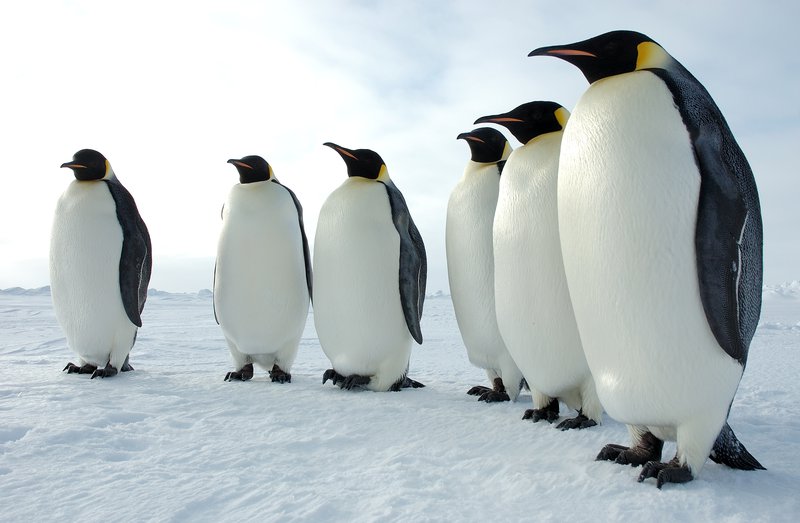
1. Emperor Penguin Proposed for United States Endangered Species Protection
The United States Fish and Wildlife Service has proposed the emperor penguin for protection under the Endangered Species Act. The species is gravely threatened by sea-ice loss driven by the climate emergency. Emperor penguins need reliable sea ice for breeding and raising their chicks. With sea ice disappearing or breaking up earlier in the year, entire emperor penguin colonies are declining or vanishing in parts of Antarctica. Recently several colonies suffered catastrophic breeding failures when sea ice broke up early before chicks were ready to swim, resulting in the drowning deaths of thousands of chicks. Scientists project that 80% of the world’s emperor penguins will disappear by 2100 without major cuts in carbon pollution. If nations meet the Paris Climate Agreement’s 1.5 degrees Celsius climate target, the penguins will suffer only a 30% decline, with the population stabilizing by the end of the century.
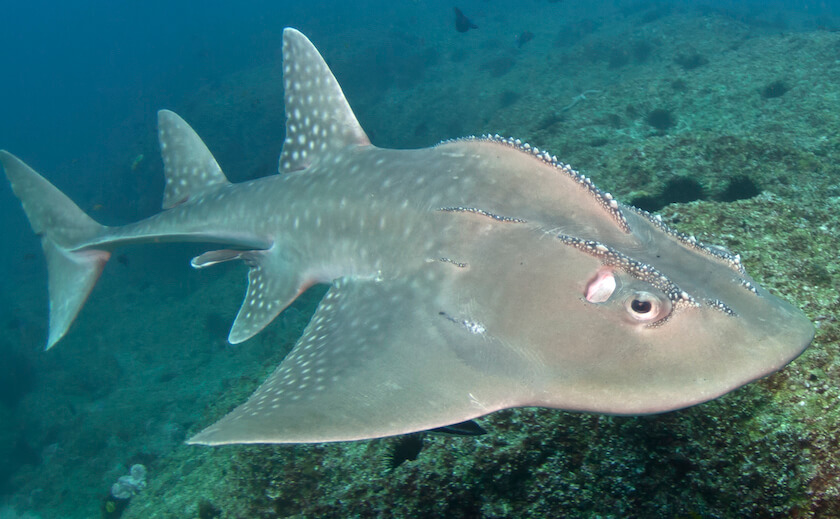
2. New Innovative Tracking Study of Critically Endangered Wedgefish in Mozambique
Scientists from the Marine Megafauna Foundation (MMF) have fitted acoustic and satellite tags to 2 species of wedgefish, kickstarting a first of its kind study in Mozambique. Bottlenose wedgefish and bowmouth guitarfish are listed as Critically Endangered, and both are species of ray and members of the wedgefish family, one of the world’s most endangered marine fish. They grow slowly, reach maturity late, and have low reproductive rates, making them particularly susceptible to population decline from overexploitation. Very little is known about their biology or ecology and consequently few management plans exist to protect declining populations worldwide. MMF researchers are working alongside park authorities and managers to identify primary aggregation sites, understand their movements, and identify the threats they may face in the region. With so little known about wedgefish and their relatives globally, researchers are intrigued to see what these tags will show.
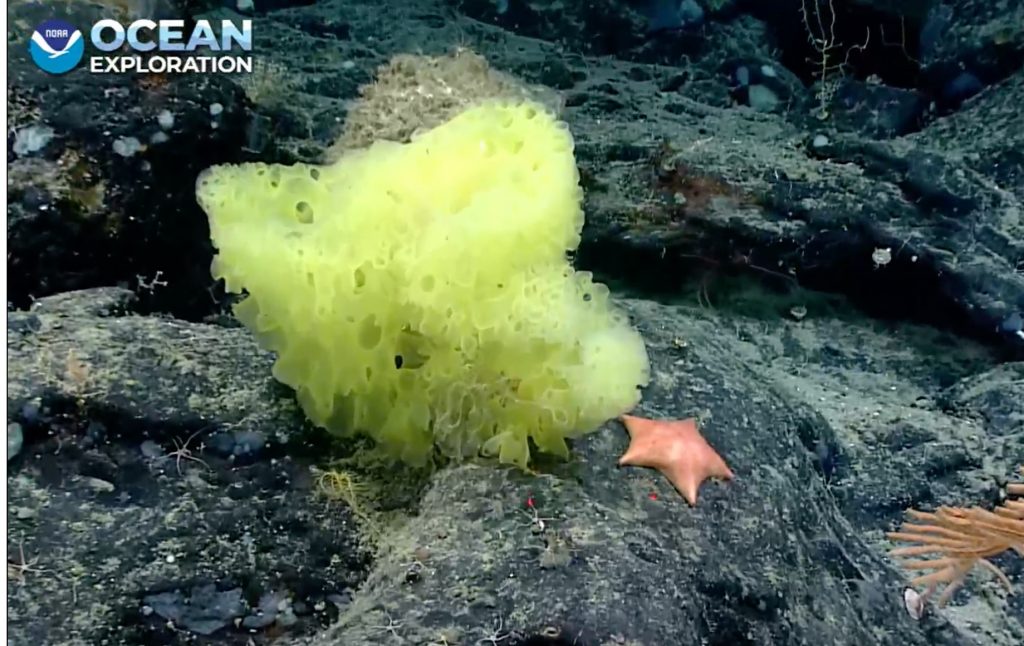
3. Scientists Find Real-Life SpongeBob SquarePants, Patrick Star in Atlantic Ocean
Divers with the National Oceanic and Atmospheric Administration (NOAA) saw a yellow sea sponge and a pink sea star resembling SpongeBob SquarePants and Patrick Star at the Retriever Seamount in the Atlantic Ocean. The team of researchers from the NOAA Okeanos Explorer ship was observing the seamount using a remotely operated vehicle (ROV) when they spotted the Hertwigia sponge and Chondraster starfish. Excited about his discovery, scientist Christopher Mah shared the picture on Twitter: “I normally avoid these refs… but WOW. REAL LIFE SpongeBob and Patrick!” While he said the comparison was fun, Mah pointed out the real-life depictions of Spongbob and Patrick are vastly different from their cartoon versions. Sea sponges are either asexual or sexual, and their reproduction stems from their body’s fragmentation, according to Our Marine Species. Starfishes are carnivores, and they eat sponge, crabs, clams, oysters, and coral.
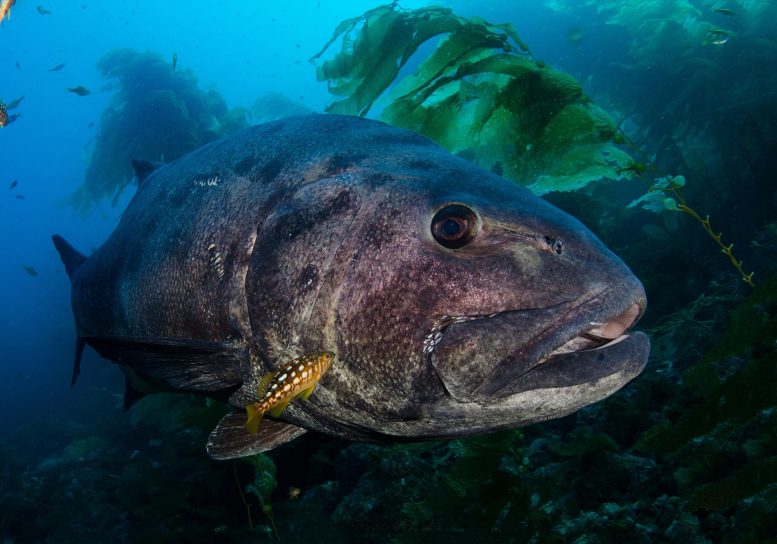
4. “Critically Endangered” Giant Sea Bass Thriving in Mexican Waters
The International Union for Conservation of Nature considers giant sea bass to be critically endangered due to the population being “severely fragmented, leading to a continuing decline of mature individuals.” But the designation never included data from Mexico, home to 73% of the species’ range. This knowledge gap made marine ecologist Arturo Ramirez-Valdez wonder if ecologists were mistaken about the health of giant sea bass populations. In 2017, he led an effort to document the giant sea bass population in Mexico and found that the fishery has been relatively stable over the past 20 years, with a peak in 2015 at 112 tons. He now believes that the giant sea bass is not a critically endangered species. His research shows how data asymmetry can impede understanding the past and present status of a species and make it harder to implement sustainable practices for the future.
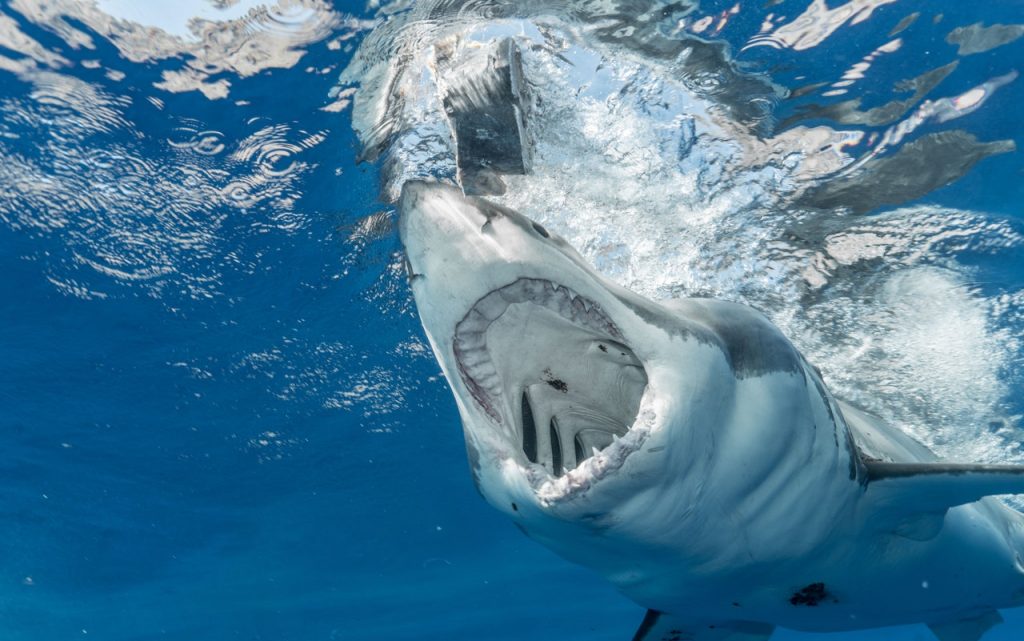
5. Study: Energetic, Nutritional Adjustments in Male Sharks Linked to Reproduction
Energetic condition influences vertebrates’ reproduction, but we do not know how energetic states change in reproduction in large marine vertebrates. In a new study, scientists assessed reproductive stage, testosterone and relative corticosteroid levels, plasma fatty acids, and the ketone body β-hydroxybutyrate interactions in the benthic nurse and the epipelagic blacktip sharks. Researchers found higher relative corticosteroid levels in adult nurse sharks during the pre-mating period and in blacktip sharks during the mating period. While adult nurse sharks had higher levels of β-hydroxybutyrate during mating, concentrations did not significantly vary across reproductive stages in blacktip sharks. Researchers found reduced percentages of essential fatty acids during mating of both nurse and blacktip sharks. Taken together, the findings suggest that nurse and blacktip sharks differ in their energetic strategy to support reproduction; however, they likely rely on physiologically important fatty acids during mating, to support sperm production.
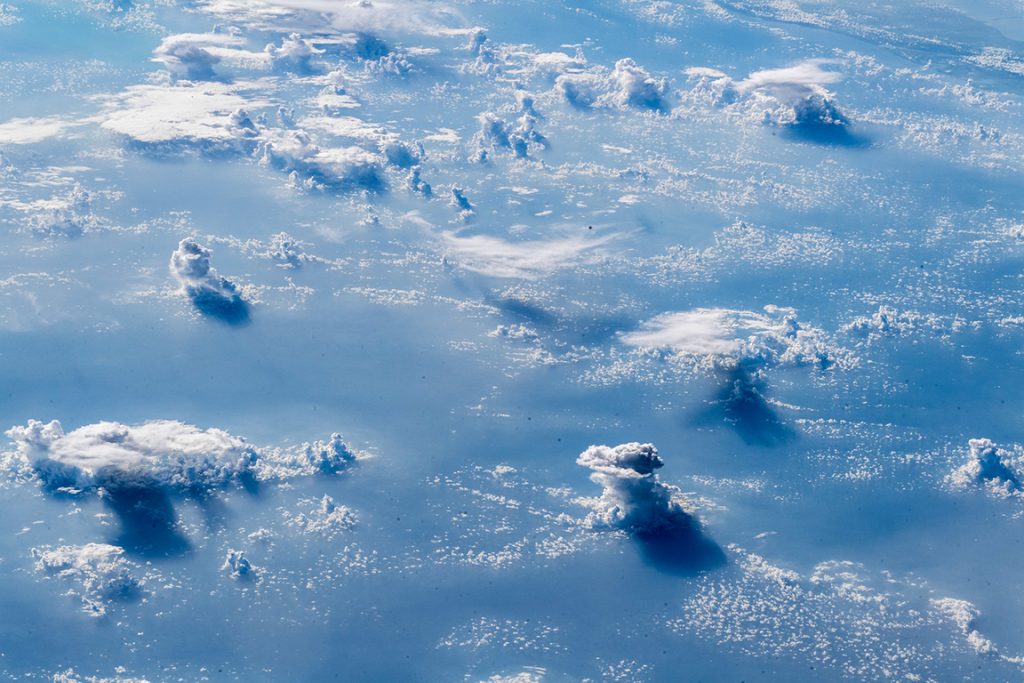
6. Passing Clouds Cause Some Marine Animals to Make Mini-Migrations
Scientists have shown that some zooplankton swim up and down in response to shifts in light due to cloud cover. The nightly trek from the ocean depths to the surface has been called the largest migration on Earth because of the number of animals making the nightly trek and the length of travel. NASA has observed this global migration with a space-based laser on the CALIPSO satellite; scientists have also documented these migrations during eclipses, full moons, and storms. Zooplankton don’t swim the full distance every time a cloud passes overhead, though, instead swimming about 50 feet on average. However, throughout the day, these “mini-migrations” add up to about 30% of the average nightly migration distance. The findings could have implications for the metabolic requirements of zooplankton, which are key to the marine food web and ocean carbon transfer.
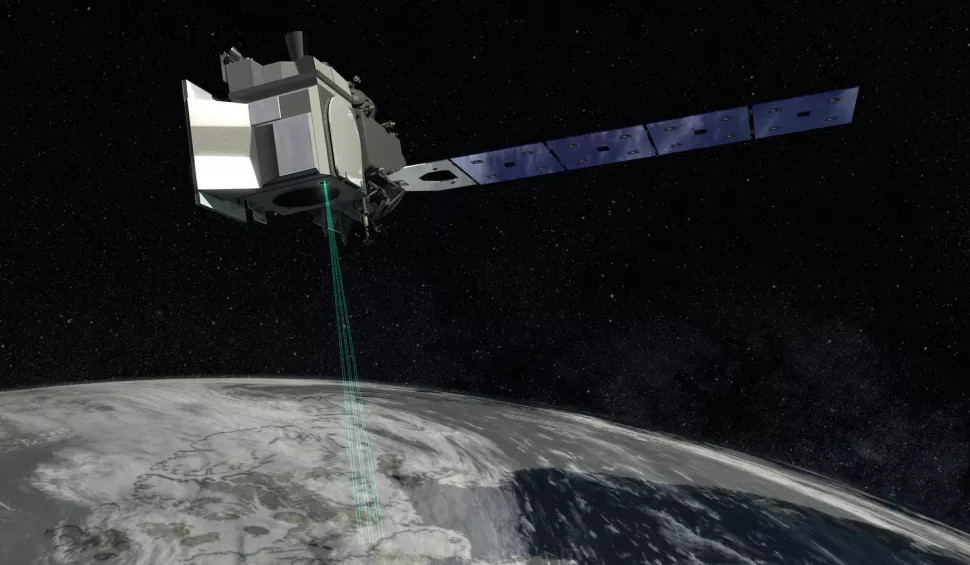
7. A Space Laser Is Tracking Subglacial Lakes Hidden in Antarctica
A NASA satellite in space that shoots a laser beam down to Earth has spotted more subsurface lakes sandwiched between Antarctica’s land and ice. Friction from the ice and the continental bedrock, fluctuations in ice pressure, and heat released from Earth create hundreds of hidden lakes that fill and drain via a network of subglacial waterways. The changing volume and shape of these subglacial lakes impacts the elevation of the ice above them. ICESat-2 studies the cryosphere and tracks the rise and fall of the Antarctic surface elevation to help scientists figure out what’s happening to the otherwise invisible lakes underneath the ice. The cryosphere is vital to cooling down Earth, storing and slowly releasing fresh water and preventing sea levels from rising. Antarctica is one of the most important segments of the cryosphere, with consequences for the rest of the planet.
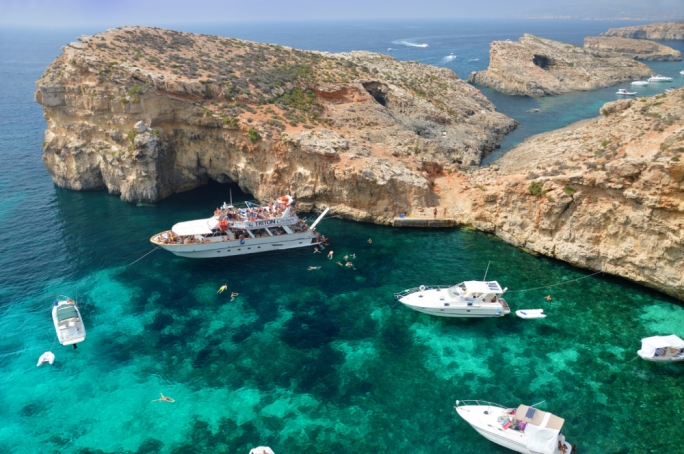
8. Marine Conservation Plan Foresees 50-Hectare Fish Revival Area
A conservation and management plan for Malta’s marine Natura 2000 sites proposes a fish revival area where fishing is restricted to address fishing pressures. Although the areas’ locations still have to be established in consultation with the fisheries sector, the document says such areas should cover over 50 hectares of sea. A ‘Fish Revival Area’ manages fisheries activity to restore fish communities. The proposal was included in the conservation objectives and measures for marine protected areas. Other proposed conservation measures include a scheme to protect exploited sea urchins from unsustainable fishing practices. The plan also proposes a code of conduct for touristic and recreational activities, including diving, boat tours, and boat parties, addressing any form of disturbance of the marine environment. It also recommends working with fishers to monitor and target non-indigenous species and promote their consumption.

9. Is Your Sunscreen Killing the Sea?
Sunscreen helps protect skin against cancer, but recently, it has come under scrutiny for being potentially toxic to the environment – especially the oceans in which sunscreen-slathered tourists swim. Estimates vary about how much sunscreen makes it into our oceans each year, but one scientist estimates that 20,000 tonnes is washed off tourists every year in the northern Mediterranean alone. The focus has been on two chemicals, the ultraviolet filters oxybenzone and octinoxate. Some filters and preservatives cause complete coral bleaching even at very low concentrations. Even some ‘eco-friendly’ products cause abnormalities in embryos and larvae. While we may think the bit of sunscreen can’t have much impact compared with the vastness of the ocean, one’ study suggested oxybenzone had a detrimental impact at 62 parts per trillion – the equivalent of one drop in six and a half Olympic-sized swimming pools.
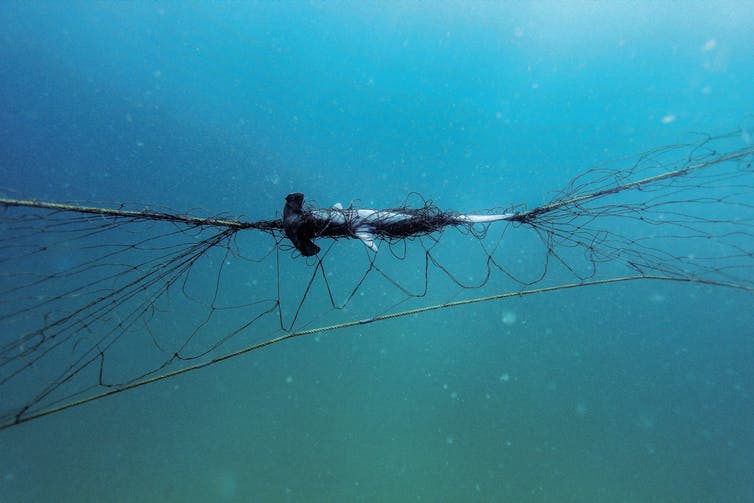
10. Over 100 Marine Animals Trapped in Queensland Shark Nets
The first major update to the Shark Culling Impact Tracker has revealed the capture of 139 more marine animals in shark nets and on lethal drumlines that span Queensland’s coastline since May 2021. Of these, 85 were killed. The Tracker, developed by Humane Society International Australia and the Australian Marine Conservation Society, is updated with data from Queensland’s Department of Agriculture and Fisheries to spotlight the direct result of lethal shark culling. Though touted to keep swimmers safe, nets and lethal drumlines provide a false sense of security at a great cost to marine life. In 2019, the Administrative Appeals Tribunal found nets and drumlines deployed in the Great Barrier Reef were ineffective for protecting swimmers from sharks. Queensland has begun to trial non-lethal alternatives that are more effective at reducing the risk of shark bite for swimmers—without adding to the mounting wildlife toll.
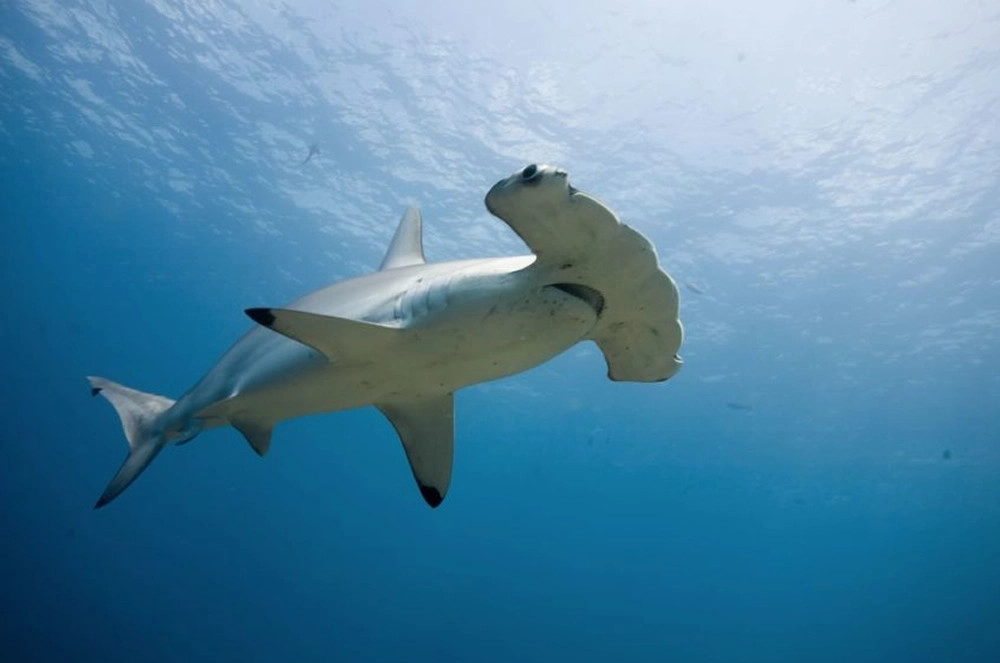
11. Conservationist Sandra Bessudo on Protecting Colombia’s Shark Paradise
500 kilometers off Colombia’s Pacific coast lies Malpelo Island, the center of the Malpelo Fauna and Flora Sanctuary World Heritage Site that is renowned for its biodiversity, especially its shark population. Malpelo’s world-class diving first drew naturalist Sandra Bessudo to the island. Bessudo founded the Malpelo Foundation and successfully pushed for the island’s listing as a World Heritage Site in 2006. In an interview, Bessudo said she is encouraged by the increased awareness for conservation today, including the problem of overfishing and illegal fishing, shark finning and extinction, and the importance of maintaining the health of strategic ecosystems like mangroves, coral reefs, sea grass, and seamounts. She would like to see sensitive parts of the high seas closed to certain activities; as long as agreements and regulations cannot extend beyond countries’ territorial waters, it will be very difficult to protect endangered species.

12. Main Threat Endangering Humpback Dolphins Is Human Activity
A new study has shown that with fewer than 500 Indian Ocean humpback dolphins in South Africa’s oceans, a strict conservation management plan is needed to save the species from extinction. The study found the main threat to the conservation of the species is the multiple and cumulative impacts of human activity in the coastal zone. Co-author Dr. Gwenith Penry said Operation Phakisa, an initiative established to develop the Oceans Economy, was an example of the unregulated growth of industries under economic imperatives without fully understanding the possible negative impacts that increased activity in the marine environment would have on ocean life. “Growth in sectors like oil and gas exploration, marine transport, harbor development and fishing/aquaculture will increase noise levels in the ocean, introduce additional pollutants and could result in unintentional habitat partitioning,” said Penry.

13. Aluminum Cans Slowly Replace Plastics to Tackle Marine Pollution
A number of Japanese beverage vendors have recently moved to replace plastic bottles with aluminum cans to combat marine plastic pollution. Ryohin Keikaku Co., operator of retail brand Muji, has sold all its teas and soft drinks in aluminum cans since April after data showed the rate of “horizontal recycling,” which allows for the reuse of materials in a comparable function, was substantially higher for such cans compared to plastic bottles. The rate of horizontal recycling for aluminum cans stands at 71% compared to 24.3% for plastic bottles, according to the Japan Aluminium Association and the Council for PET Bottle Recycling. Plastic bottles weaken over multiple bouts of recycling, resulting in their reshaping into plastic food trays. Aluminum cans also better prevent their contents from deteriorating since their opacity keeps light from damaging them, preserving contents longer and avoiding needless waste.

14. App Helps Restaurants Switch to Sustainable Packaging
The Jybe app is helping restaurants transition to materials that do the least harm to the environment. Paul Kradin, Jybe’s chief sustainability officer, noted that they’ve identified recyclable, biodegradable, or renewable items made from materials such as aluminum, birch wood, and paper. “It will biodegrade over time if it’s disposed of in a landfill, if it gets blown to the side of the street,” Kradin said of coffee lids that cost the same as plastic. Jybe’s mission is also educational because many people don’t realize how broken the recycling system is. Only 9% of America’s single-use plastic is recycled each year. “The only way for us to make a real difference is to stop using it in the first place,” Kradin said. Lisanne Magnus, general manager of the restaurant Mohawk Bend, uses the app to avoid contributing to the plastic pollution crisis.
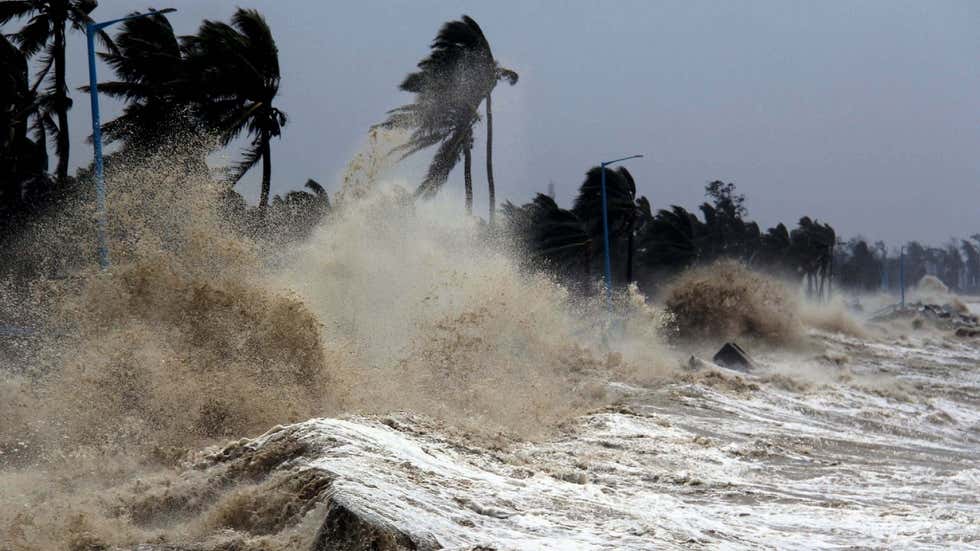
15. New IPCC Report: Indian Ocean Warming at Higher Rate Than Global Oceans
According to the new report from the Intergovernmental Panel on Climate Change (IPCC), a United Nations organisation, the sea level around Asia has increased faster than the global average, with coastal area loss and shoreline retreat. The sea level extremes that previously occurred once in 100 years could happen once every six to nine years by 2050, and every year by 2100 globally, says Swapna Panickal, a scientist at the Indian Institute of Tropical Meteorology. She said the Indian Ocean is warming faster than the global oceans. If the earth warms by 1.5 degrees, the sea temperature is expected to increase by one degree. The global sea level and Indian Ocean sea level is also projected to rise at a similar rate. The 1.5-degree goal requires a 50% reduction in emissions by 2030 and net-zero by 2050.
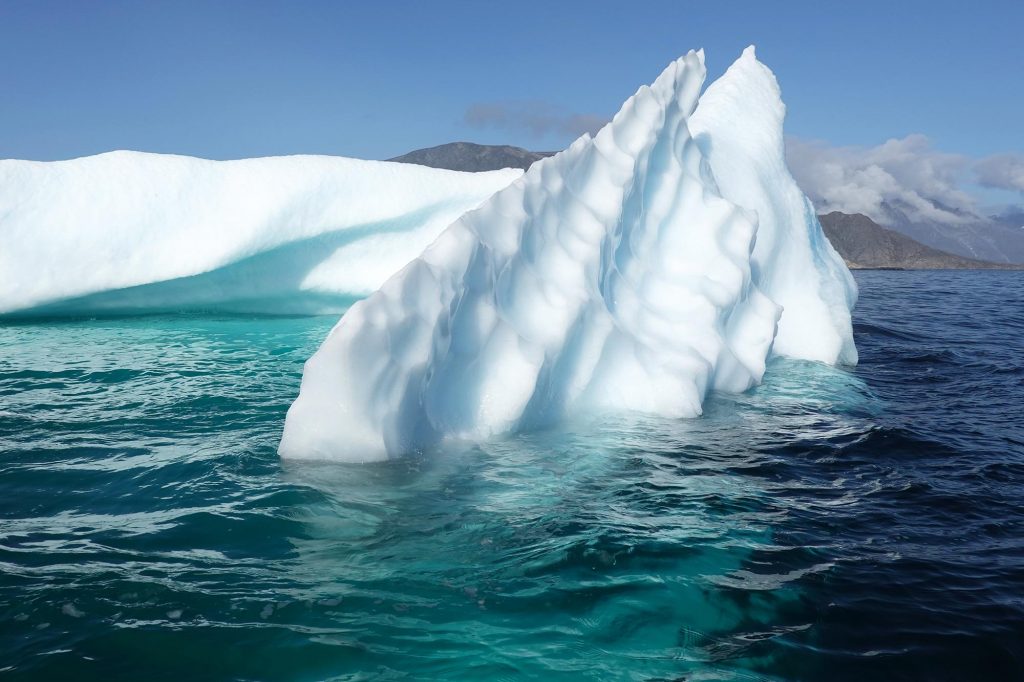
16. Why the Atlantic Ocean Current System Is Slowing Down, and Its Implications
A new study in Nature Climate Change notes that the Atlantic Meridional Overturning Circulation (AMOC) is losing its stability. The Intergovernmental Panel on Climate Change’s new report says the AMOC will likely decline over the 21st century. Scientist Niklas Boers explains: “The findings support the assessment that the AMOC decline is not just a fluctuation or a linear response to increasing temperatures but likely means the approaching of a critical threshold beyond which the circulation system could collapse.” The AMOC is a large system of ocean currents and the Atlantic branch of the ocean conveyor belt that distributes heat and nutrients throughout the world’s ocean basins. “If we continue to drive global warming, the Gulf Stream System will weaken further – by 34-45% by 2100,” notes scientist Stefan Rahmstorf. “This could bring us dangerously close to the tipping point at which the flow becomes unstable.”
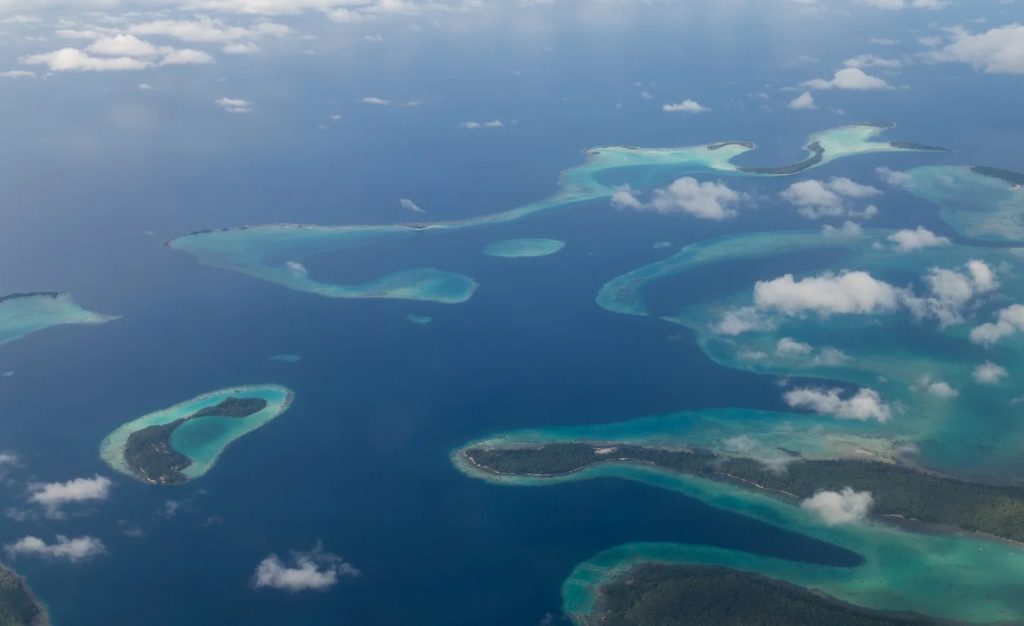
17. Oceans are Swallowing Islands Due to Climate Change
The consequences of climate change aren’t far off — in fact, for residents of the Solomon Islands, they’re already here. At least 11 islands across the northern Solomon Islands have either totally disappeared over recent decades or are experiencing severe erosion. Along with the island, its infrastructure and entire ecosystem is at risk, including the salt-tolerant mangrove trees that feed many local communities and water supply. Locals are spearheading conservation efforts alongside other solutions, such as constructing homes on higher stilts above water and building stone walls to protect them from the sea. Photo above, and others have been taken to reveal the gradual disappearance of the island of Kale.

18. Geopolitical standoff in South China Sea Leads to Environmental Fallout
A long-running territorial standoff over the Spratly Islands in the South China Sea has seen vessels dumping enough raw sewage to threaten the marine ecosystem there — and the degradation is extensive enough to be seen from space. “There is significant evidence that the Union Banks reefs are being damaged by ‘excess nutrients’ and have more reef degrading microalgae than similar reefs which are not occupied,” Simularity said in its Aug. 11 report. “The importance of understanding the biological processes in the ocean cuts across several aspects, from managing fisheries to mitigating the impacts of harmful algal blooms,” Perez said. “This vital information can then be mobilized to address environmental concerns and climate change impacts as we come up with efficient approaches in managing and ensuring the sustainability of our marine resources.”
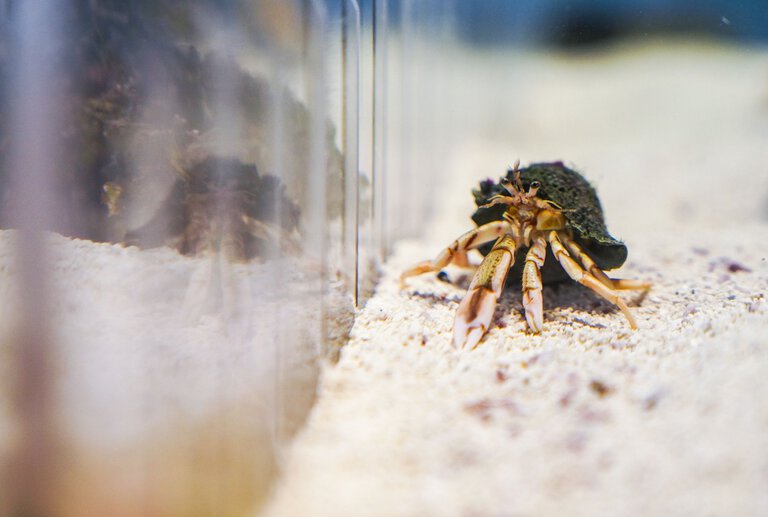
19. Hermit Crabs ‘Sexually Excited’ by Plastic Pollution in Ocean
A chemical leaked from plastic dumped in the ocean is probably arousing hermit crabs, according to researchers studying the impact of climate change, plastic, and other molecules on marine species. Scientists from England’s University of Hull examined 40 crabs found in the waters off the Yorkshire coast and found signs that the crustaceans may be “sexually excited” by oleamide, an additive released by plastics found under the sea. Oleamide elevates the respiration rate of hermit crabs, which indicates excitement, researchers said, adding that the product is considered a sex pheromone for some insects. “Our study shows that oleamide attracts hermit crabs,” PhD candidate Paula Schirrmacher said. Schirrmacher noted that oleamide has “a striking resemblance to oleic acid, a chemical released by arthropods during decomposition,” which may explain why it is mistaken for food and ingested by animals – potentially increasing their consumption of microplastics.
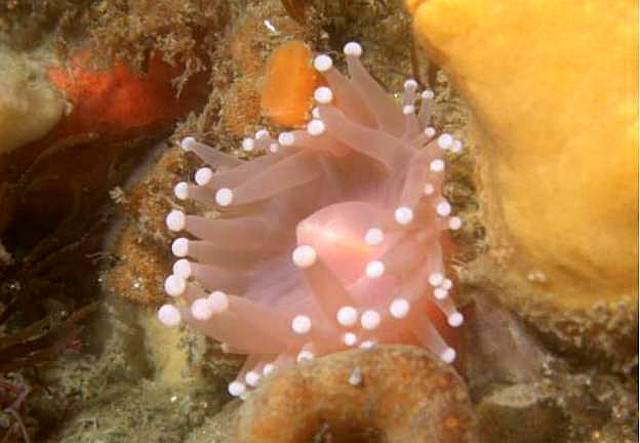
20. Insidious Coral Killer Invading Palmyra Atoll Reef
The reefs at Palmyra Atoll, a small outlying atoll in the equatorial Pacific Ocean, have been undergoing a shift from stony corals to systems dominated by corallimorphs, marine invertebrates that share traits with both anemones and hard corals. Marine biology researchers discovered that although the invading corallimorph is the same species that has been there for decades, its appearance recently changed, and it became much more insidious. Because of their adaptability, corallimorphs are excellent competitors. In addition to being able to kill corals directly, they can quickly move into disturbed areas and out-compete surrounding organisms, creating a sort of blanket on the reef. There is concern among scientists and conservationists that the phase shift from stony coral-dominated habitats may be irreversible due to a negative feedback loop of coral decline and subsequent algal, sponge or corallimorph domination.
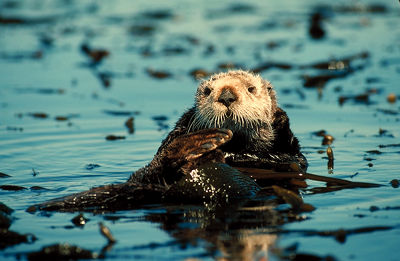
21. Canada Launches Proposals for Projects that Protect Aquatic Species at Risk
Canada’s natural biodiversity plays an important role in our way of life. The Honourable Bernadette Jordan, Minister of Fisheries, Oceans and the Canadian Coast Guard, announced a new Call for Proposals for the Canada Nature Fund for Aquatic Species at Risk (CNFASAR). The fund aims to support the recovery and protection of aquatic species at risk by enabling multi-species, place-based and threat-based approaches to recovery. A total of $28.95 million, through Budget 2021, will go toward CNFASAR projects as part of the Enhanced Nature Legacy initiative over five years, starting in 2021-22. This includes $4.15 million over five years to support the consideration of Indigenous knowledge and capacity building. These federal investments will directly support aquatic conservation and species at risk across the country and in Canada’s oceans.
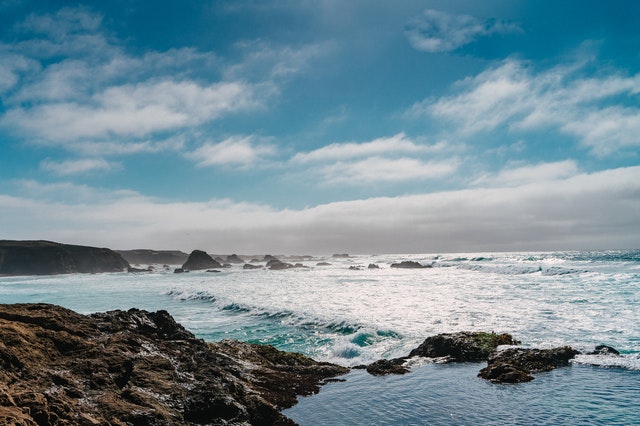
22. California’s New Plan to Protect Marine Life May Be Model for World
The ocean helps regulate our climate and provides oxygen and food, but the size of marine populations declined by almost half between 1970 and 2012. Unless something changes, the world’s oceans could be in serious trouble. California has a network of 124 Marine Protected Areas (MPAs), which is the second-largest MPA network in the world behind Australia’s Great Barrier Reef. The network covers over 16% of state waters, all meant to protect marine habitats and the variety of life they support. What makes California’s effort unique is the interconnected network of MPAs, each assigned one of three levels of protection designed to increase the effectiveness of protected oceans by working in concert up and down the coast. Established in 2012, a 10-year management review is coming to identify what works along the California coast and that could be shared around the world.
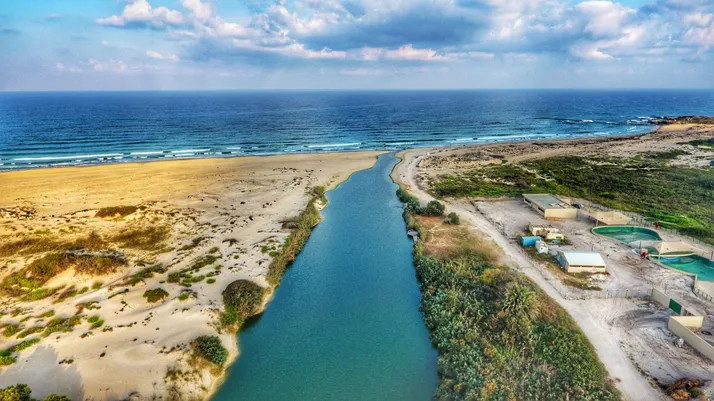
23. Seaweed Shown to Reduce Nitrogen Run-Off From Rivers
A new study by Tel Aviv University and Berkeley University suggests establishing seaweed farms near river estuaries significantly reduces nitrogen concentrations and prevents environmental pollution in streams and oceans. Researchers built a model for growing Mediterranean stalk kelp near the Alexander River estuary in Israel, hundreds of metres from the open sea. The river was chosen because it discharges polluting nitrogen from nearby upstream fields and settlements into the Mediterranean. Data for the model were collected over two years from controlled cultivation studies. Nitrogen is a necessary fertilizer for agriculture, but in the ocean, it disperses randomly, damaging ecosystems. The government currently treats nitrogen concentrations at great cost. International agreements limit nitrogen loading in the ocean.. “We actually produced a kind of ‘natural decontamination facility’ with significant ecological and economic value since seaweed can be sold as biomass for human use,” said a study coauthor.
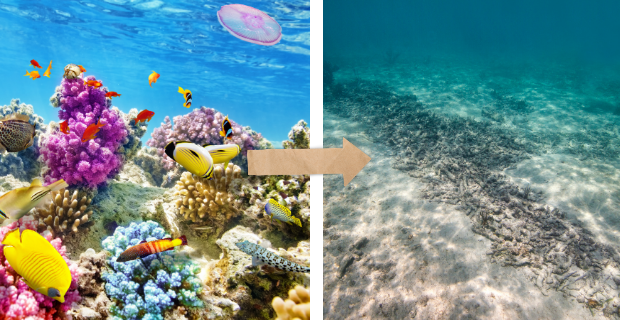
24. Study Identifies Presence of Pesticides Among Coral Reefs
A recent study published in Chemosphere identifies the concentration, consequences, and potential sources of 22 organochlorine pesticides (OCPs) among corals in the South China Sea (SCS) for the first time. The study also found atmospheric concentrations of OCPs—influenced by continental air masses—migrate from the atmosphere to seawater through gas exchange. The study results indicate 17 OCPs are detectable in seawater, and 22 OCPs are detectable in ambient air samples from the SCS. Although coastal corals have higher chemical concentrations than offshore species, the chemical composition is similar. Researchers attribute the difference in OCP concentration among coastal and offshore corals to oceanic currents and storms influencing pollution distribution. Long-range atmospheric transport and condensation contribute to the global contamination of environmental pollutants. Most concerning are the persistent properties that allow OCPs to remain in the environment long after use.

25. Samsung May Use Ocean Plastic in Future Phones
Samsung is the most recent Big Tech company to embrace a stronger pro-planet pledge, announcing at its Samsung Unpacked launch event that it will eliminate all single-use plastic from its smartphone packaging by 2025. Its new sustainability platform, Galaxy for the Planet, will focus on slashing waste from the production to the disposal of its Galaxy line of products. The news comes the same week as a United Nations climate report urged policymakers to reduce emissions to slow down rapidly progressing climate change. Samsung also plans to use recycled material in all new its mobile products by 2025, from phones to earbuds. This is where ocean plastic comes in, one possible material Samsung plans to experiment with to make future phones. These concrete goals toward sustainability could push the rest of the phone manufacturing industry to take similar steps.
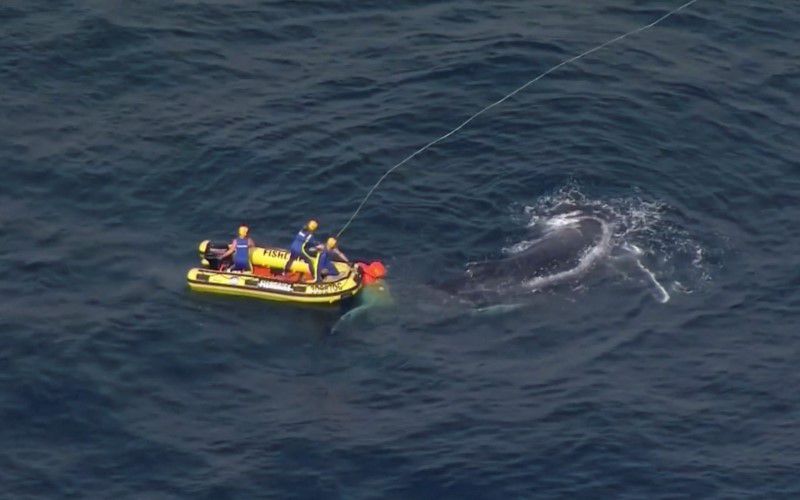
26. Marine Rescuers Work to Free Whale Caught in Shark Net
Australian marine rescuers are working to free a humpback whale tangled in a shark net off Queensland’s Gold Coast. Footage showed Sea World staff reaching out to try and cut netting off the whale’s tail as it thrashed. The rescue effort began when surfers tried to free the trapped animal. Marine mammal park Sea World and the Queensland Department of Fisheries then took over, as members of the whale pod stayed close by, but the rescue attempt had to be stopped later that day because of choppy water conditions. A tracker was placed on the 8-metre-long whale before it was released, so it could be located the next day. Six whales were entangled in shark nets on the Gold Coast in 2020 and all were successfully released. The nets are used across Australia’s northeast coast to reduce shark numbers in the area.




